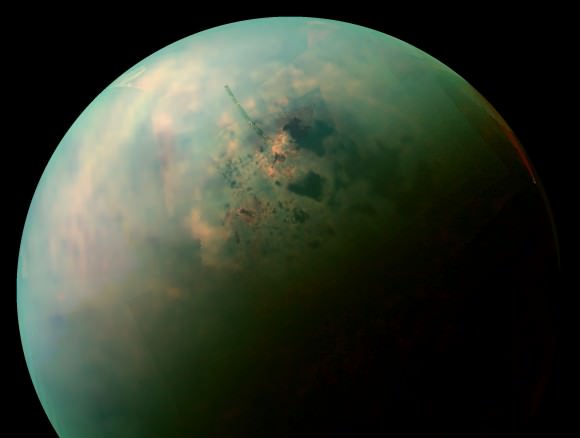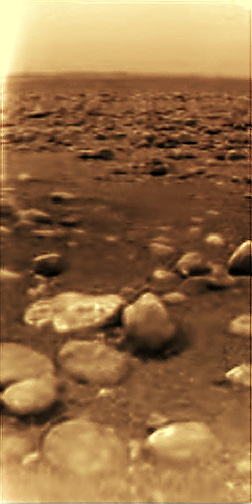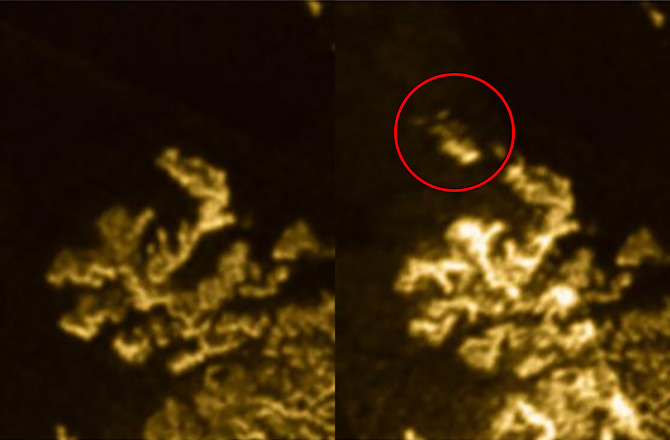Saturn’s largest Moon, Titan, is the only other world in our Solar System that has stable liquid on its surface. That alone, and the fact that the liquid is composed of methane, ethane, and nitrogen, makes it an object of fascination. The bright spot features that Cassini observed in the methane seas that dot the polar regions only deepen the fascination.
A new paper published in Nature Astronomy digs deeper into a phenomenon in Titan’s seas that has been puzzling scientists. In 2013, Cassini noticed a feature that wasn’t there on previous fly-bys of the same region. In subsequent images, the feature had disappeared again. What could it be?
One explanation is that the feature could be a disappearing island, rising and falling in the liquid. This idea took hold, but was only an initial guess. Adding to the mystery was the doubling in size of these potential islands. Others speculated that they could be waves, the first waves observed anywhere other than on Earth. Binding all of these together was the idea that the appearance and disappearance could be caused by seasonal changes on the moon.

Now, scientists at NASA’s Jet Propulsion Laboratory (JPL) think they know what’s behind these so-called ‘disappearing islands,’ and it seems like they are related to seasonal changes.
The study was led by Michael Malaska of JPL. The researchers simulated the frigid conditions on Titan, where the temperature is -179.2 Celsius. At that temperature, some interesting things happen to the nitrogen in Titan’s atmosphere.
On Titan, it rains. But the rain is composed of extremely cold methane. As that methane falls to the surface, it absorbs significant amounts of nitrogen from the atmosphere. The rain hits Titan’s surface and collects in the lakes on the moon’s polar regions.
The researchers manipulated the conditions in their experiments to mirror the changes that occur on Titan. They changed the temperature, the pressure, and the methane/ethane composition. As they did so, they found that nitrogen bubbled out of solution.
“Our experiments showed that when methane-rich liquids mix with ethane-rich ones — for example from a heavy rain, or when runoff from a methane river mixes into an ethane-rich lake — the nitrogen is less able to stay in solution,” said Michael Malaska of JPL. This release of nitrogen is called exsolution. It can occur when the seasons change on Titan, and the seas of methane and ethane experience a slight warming.
“Thanks to this work on nitrogen’s solubility, we’re now confident that bubbles could indeed form in the seas, and in fact may be more abundant than we’d expected,” said Jason Hofgartner of JPL, a co-author of the study who also works on Cassini’s radar team. These nitrogen bubbles would be very reflective, which explains why Cassini was able to see them.

The seas on Titan may be what’s called a prebiotic environment, where chemical conditions are hospitable to the appearance of life. Some think that the seas may already be home to life, though there’s no evidence of this, and Cassini wasn’t equipped to investigate that premise. Some experiments have shown that an atmosphere like Titan’s could generate complex molecules, and even the building blocks of life.
NASA and others have talked about different ways to explore Titan, including balloons, a drone, splashdown landers, and even a submarine. The submarine idea even received a NASA grant in 2015, to develop the idea further.
So, mystery solved, probably. Titan’s bright spots are neither islands nor waves, but bubbles.
Cassini’s mission will end soon, and it’ll be quite some time before Titan can be investigated further. The question of whether Titan’s seas are hospitable to the formation of life, or whether there may already be life there, will have to wait. What role the nitrogen bubbles play in Titan’s life question will also have to wait.


“No evidence of life”?
What about
https://en.m.wikipedia.org/wiki/Life_on_Titan
Quote: In 2005, astrobiologists Chris McKay and Heather Smith predicted that if methanogenic life is consuming atmospheric hydrogen in sufficient volume, it will have a measurable effect on the mixing ratio in the troposphere of Titan. The effects predicted included a level of acetylene much lower than otherwise expected, as well as a reduction in the concentration of hydrogen itself.[30]
Evidence consistent with these predictions was reported in June 2010 by Darrell Strobel of Johns Hopkins University, who analysed measurements of hydrogen concentration in the upper and lower atmosphere. Strobel found that the hydrogen concentration in the upper atmosphere is so much larger than near the surface that the physics of diffusion leads to hydrogen flowing downwards at a rate of roughly 1025 molecules per second. Near the surface the downward-flowing hydrogen apparently disappears.[29][30][31] Another paper released the same month showed very low levels of acetylene on Titan’s surface.[29]
The very next paragraph:
“Chris McKay agreed with Strobel that presence of life, as suggested in McKay’s 2005 article, is a possible explanation for the findings about hydrogen and acetylene, but also cautioned that other explanations are currently more likely: namely the possibility that the results are due to human error, to a meteorological process, or to the presence of some mineral catalyst enabling hydrogen and acetylene to react chemically.[1][32] He noted that such a catalyst, one effective at -178 °C (95 K), is presently unknown and would in itself be a startling discovery, though less startling than discovery of an extraterrestrial life form”
I guess we won’t know for sure until we go back
Regardless of the *interpretation* or *explanation* it is *evidence* being considered. There is *evidence* of something and it could be life.
But yes it will take a lot of work to get back there to take a look.